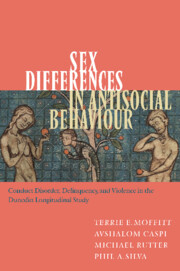 Sex Differences in Antisocial Behaviour
Sex Differences in Antisocial Behaviour Book contents
- Frontmatter
- Contents
- List of figures
- List of tables
- Preface
- Acknowledgements
- 1 Introduction
- 2 The Dunedin Multidisciplinary Health and Development Study
- 3 Sex differences in the amount of antisocial behaviour: dimensional measures
- 4 Sex differences in the prevalence of antisocial behaviour: categorical diagnostic measures
- 5 Sex differences in physical violence and sex similarities in partner abuse
- 6 Sex and the developmental stability of antisocial behaviour
- 7 Sex and the age of onset of delinquency and conduct disorder
- 8 Sex effects in risk predictors for antisocial behaviour: are males more vulnerable than females to risk factors for antisocial behaviour?
- 9 Sex effects in risk predictors for antisocial behaviour: are males exposed to more risk factors for antisocial behaviour?
- 10 Can sex differences in personality traits help to explain sex differences in antisocial behaviour?
- 11 Sex and comorbidity: are there sex differences in the co-occurrence of conduct disorder and other disorders?
- 12 Do girls who develop antisocial behaviour surmount a higher threshold of risk than their male counterparts?
- 13 Sex differences in the effects of antisocial behaviour on young adult outcomes
- 14 Sex, antisocial behaviour, and mating: mate selection and early childbearing
- 15 Evaluating the recommendation to relax the criteria for diagnosing conduct disorder in girls
- 16 Life-course persistent and adolescence-limited antisocial behaviour among males and females
- 17 Priorities for a research agenda
- References
- Index
11 - Sex and comorbidity: are there sex differences in the co-occurrence of conduct disorder and other disorders?
Published online by Cambridge University Press: 22 September 2009
- Frontmatter
- Contents
- List of figures
- List of tables
- Preface
- Acknowledgements
- 1 Introduction
- 2 The Dunedin Multidisciplinary Health and Development Study
- 3 Sex differences in the amount of antisocial behaviour: dimensional measures
- 4 Sex differences in the prevalence of antisocial behaviour: categorical diagnostic measures
- 5 Sex differences in physical violence and sex similarities in partner abuse
- 6 Sex and the developmental stability of antisocial behaviour
- 7 Sex and the age of onset of delinquency and conduct disorder
- 8 Sex effects in risk predictors for antisocial behaviour: are males more vulnerable than females to risk factors for antisocial behaviour?
- 9 Sex effects in risk predictors for antisocial behaviour: are males exposed to more risk factors for antisocial behaviour?
- 10 Can sex differences in personality traits help to explain sex differences in antisocial behaviour?
- 11 Sex and comorbidity: are there sex differences in the co-occurrence of conduct disorder and other disorders?
- 12 Do girls who develop antisocial behaviour surmount a higher threshold of risk than their male counterparts?
- 13 Sex differences in the effects of antisocial behaviour on young adult outcomes
- 14 Sex, antisocial behaviour, and mating: mate selection and early childbearing
- 15 Evaluating the recommendation to relax the criteria for diagnosing conduct disorder in girls
- 16 Life-course persistent and adolescence-limited antisocial behaviour among males and females
- 17 Priorities for a research agenda
- References
- Index
Summary
In this chapter, we compare the sexes on disorders and psychiatric conditions that co-occur with antisocial disorders during the developmental period from ages 11 to 21. We examine mental retardation, reading retardation, attention deficit-hyperactivity disorder (ADHD), anxiety disorders, depression and dysthymia, mania, eating disorders, alcohol and marijuana dependence, and schizophreniform symptoms. The chapter addresses three issues. How common is comorbidity among young people who have conduct disorder? What is the pattern of cumulative co-occurrence of conduct disorder with other disorders across the period of the life span we study, and does this pattern differ for males and females? Are there changing patterns of comorbidity with conduct problems across the repeated assessments of the study, and do those patterns differ for males and females?
In recent years awareness has increased about the phenomenon of comorbidity, the concurrent diagnosis of two or more mental disorders within the same individual. Epidemiological studies show that approximately half of all persons with a mental disorder have more than one diagnosable disorder (Clark, Watson, and Reynolds, 1995). The ubiquity of comorbidity has implications for research methodology, clinical practice, and diagnostic nosologies (Caron and Rutter, 1991; Angold, Costello and Erkanli, 1999). With respect to research methodology, it has been shown that comorbidity can confound developmental studies of the onset and course of a disorder (Sher and Trull, 1996).
- Type
- Chapter
- Information
- Sex Differences in Antisocial BehaviourConduct Disorder, Delinquency, and Violence in the Dunedin Longitudinal Study, pp. 135 - 150Publisher: Cambridge University PressPrint publication year: 2001
- 2
- Cited by
